Mitsubishi Outlander (2022 year). Manual in english - page 19
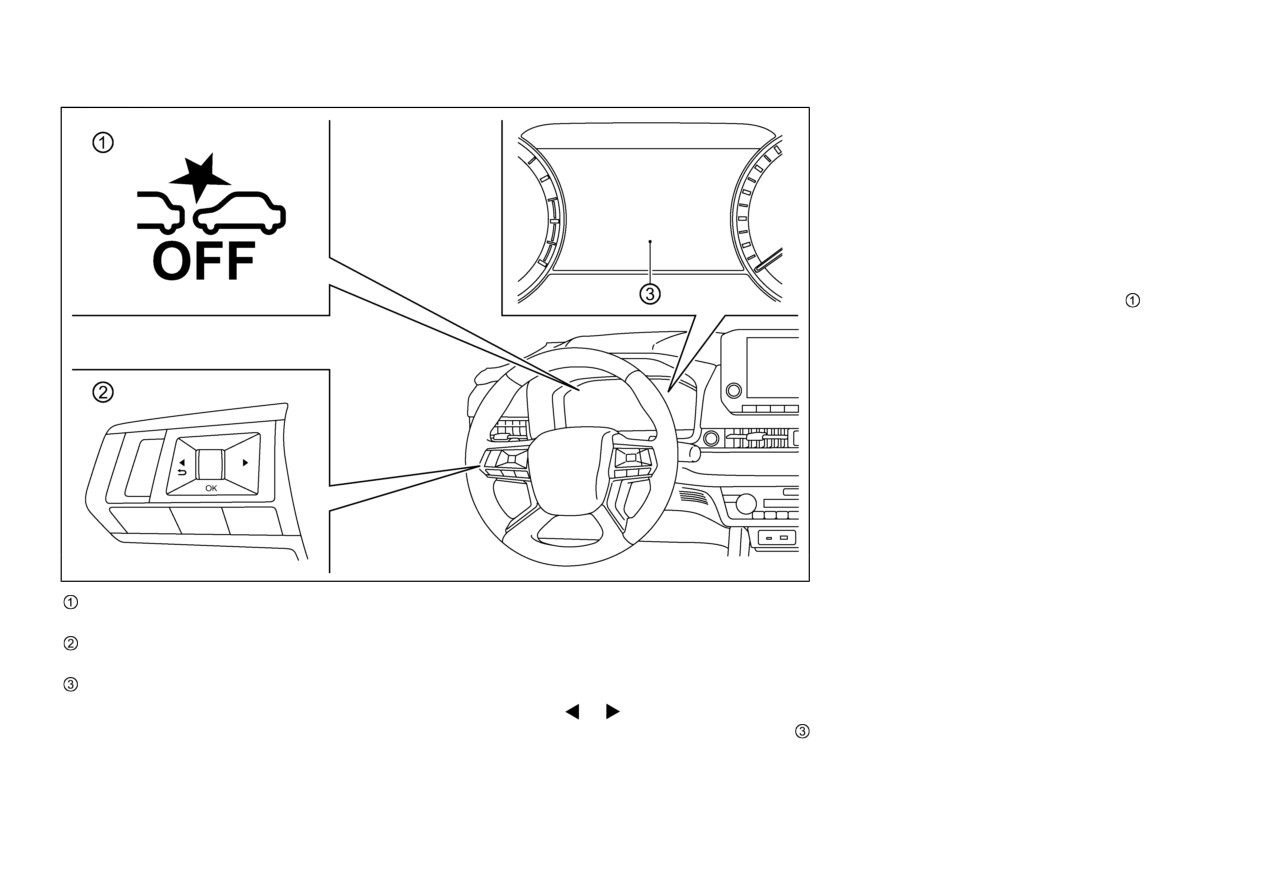
and then push the scroll dial. Use the scroll
dial to select
“Driver Assistance.” Then
push the scroll dial.
2. Select
“Emergency Brake” and push the
scroll dial.
3. Select “Front” and use the scroll dial to turn
the system on or off.
When the PFCW system is turned off, the FCM
system OFF warning light (orange)
illumi-
nates.
NOTE:
. The PFCW system will be automatically
turned on when the engine is restarted.
. The PFCW system is integrated into the
FCM system. There is not a separate
selection in the display for the PFCW
system. When the FCM system is turned
off, the PFCW system is also turned off.
WAF0623X
FCM system OFF warning light (on the meter
TURNING THE PFCW SYS-
panel)
Steering wheel remote control switches
(left
TEM ON/OFF
side)
Perform the following steps to turn the PFCW
Multi-information display
system on or off.
1. Press the
button until “Settings”
appears in the multi-information display
5-138
Starting and driving

JVS0295X
JVS0296X
Illustration A
Illustration B
JVS0297X
Illustration C
Starting and driving
5-139
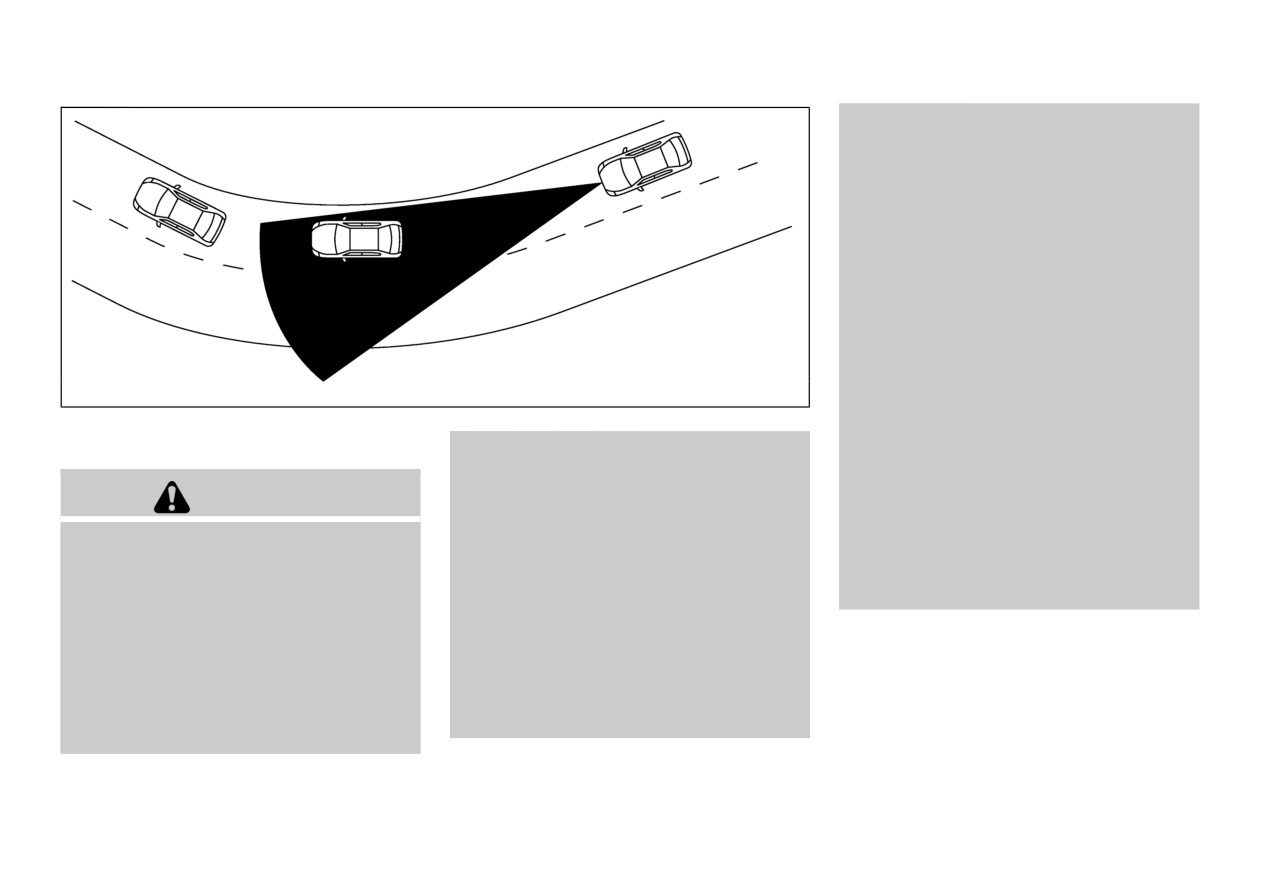
— Snow or road spray from travel-
ling vehicles.
— Driving in a tunnel
— Towing a trailer
(Illustration B) When the vehicle ahead is
being towed.
(Illustration C) When the distance to the
vehicle ahead is too close, the beam of the
radar sensor is obstructed.
(Illustration D) When driving on a steep
downhill slope or roads with sharp curves.
The system is designed to automatically
JVS0298X
check the sensor’s functionality, within
Illustration D
certain limitations. The system may not
detect some forms of obstruction of the
PFCW SYSTEM LIMITATIONS
— Oncoming vehicles
sensor area such as ice, snow, stickers, for
example. In these cases, the system may
— Crossing vehicles
not be able to warn the driver properly. Be
WARNING
(Illustration A) The PFCW
system does
sure that you check, clean and clear the
not function when a vehicle ahead is a
sensor area regularly.
Listed below are the system limitations for the
narrow vehicle, such as a motorcycle.
PFCW system. Failure to operate the vehicle in
Excessive noise will interfere with the
accordance with these system limitations could
The radar sensor may not detect a vehicle
warning chime sound, and the chime may
result in serious injury or death.
ahead in the following conditions:
not be heard.
— Snow or heavy rain
. The PFCW system cannot detect all
vehicles under all conditions.
— Dirt, ice, snow or other material
. The radar sensor does not detect the
covering the radar sensor
following objects:
— Interference by other radar
— Pedestrians, animals or obstacles
sources
in the roadway
5-140
Starting and driving
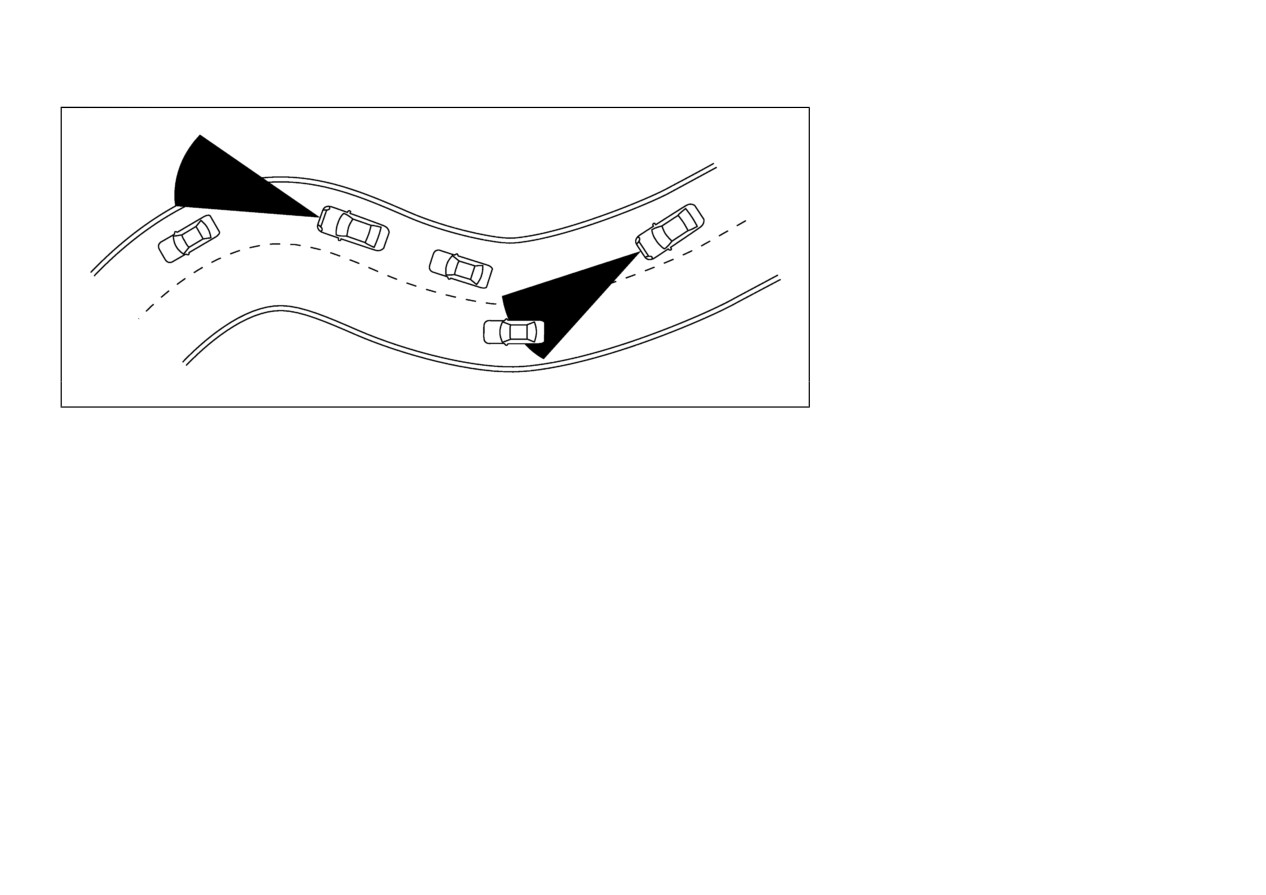
Condition B
Under the following conditions, making it
impossible to detect a vehicle ahead, the PFCW
system is automatically turned off.
The FCM system OFF warning light (orange)
will illuminate and the “Forward Driving Aids
temporarily disabled Front Sensor blocked”
warning message will appear in the multi-
information display.
. When the sensor area of the front of the
vehicle is covered with dirt or is obstructed
Action to take:
SSD0253
If the FCM system warning light
(orange)
comes on, stop the vehicle in a safe place, push
When driving on some roads, such as winding,
SYSTEM TEMPORARILY UN-
the park button to shift to the P (Park) position
hilly, curved, narrow roads, or roads which are
and turn the engine off. Clean the radar cover on
AVAILABLE
under construction, the radar sensor may detect
the vehicle front area with a soft cloth, and
vehicles in a different lane, or may temporarily
Condition A
restart the engine. If the warning light continues
not detect a vehicle traveling ahead. This may
to illuminate, check that the cover of the sensor
When the radar sensor picks up interference
cause the PFCW system to work inappropri-
is not covered by dirt, snow or ice. If the
from another radar source, making it impossible
ately.
warning light is still illuminated, have the
to detect a vehicle ahead, the PFCW system is
The detection of vehicles may also be affected
PFCW system checked. It is recommended
automatically turned off. The FCM system OFF
by vehicle operation
(steering maneuver or
you visit an authorized Mitsubishi Motors
warning light (orange) will illuminate.
traveling position in the lane, etc.) or vehicle
dealer for this service.
Action to take:
condition. If this occurs, the system may warn
. When driving on roads with limited road
you by blinking the vehicle ahead detection
When the above conditions no longer exist, the
structures or buildings (for example, long
indicator and sounding the chime unexpect-
PFCW system will resume automatically.
bridges, deserts, snow fields, driving next to
edly. You will have to manually control the
long walls)
proper distance away from the vehicle
traveling ahead.
Starting and driving
5-141
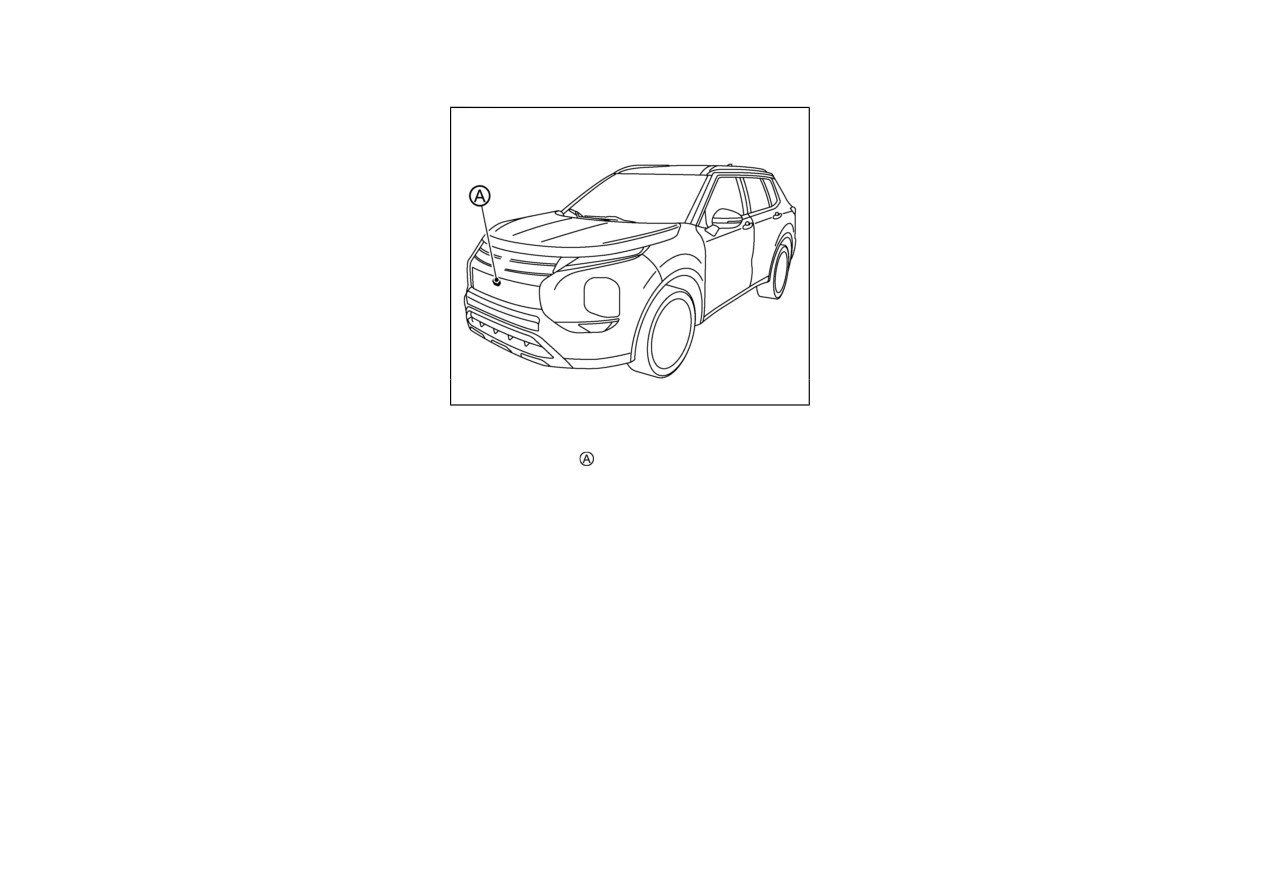
Action to take:
. Do not attach metallic objects near the
sensor area (brush guard, etc.). This could
When the above conditions no longer exist, the
cause failure or malfunction.
PFCW system will resume automatically.
. Do not alter, remove or paint the front
SYSTEM MALFUNCTION
bumper. It is recommended you contact an
If the PFCW system malfunctions, it will be
authorized Mitsubishi Motors dealer before
turned off automatically, a chime will sound, the
customizing or restoring the front bumper.
FCM system warning light
(orange) will
Radio frequency statement
illuminate and the warning message "Malfunc-
tion" will appear in the multi-information
For USA
display.
Type approval number:
Action to take:
FCC ID: NF3-FR5CPEC
If the warning light (orange) illuminates, stop
User Manual statement according to §15.19:
WAF0395X
the vehicle in a safe location. Turn the engine
This device complies with Part 15 of the FCC
off and restart the engine. If the warning light
SYSTEM MAINTENANCE
Rules.
continues to illuminate, have the PFCW system
checked. It is recommended you visit an
The radar sensor is located on the front of the
Operation is subject to the following two
authorized Mitsubishi Motors dealer for this
vehicle.
conditions:
service.
To keep the system operating properly, be sure
1. this device may not cause harmful inter-
to observe the following:
ference, and
. Always keep the sensor area on the vehicle
2. this device must accept any interference
front area clean.
received, including interference that may
. Do not strike or damage the areas around
cause undesired operation.
the sensor.
User Manual statement according to §15.21:
. Do not cover or attach stickers or similar
Changes or modifications made to this equip-
objects on the vehicle front area near the
ment not expressly approved by Robert BOSCH
sensor area. This could cause failure or
GmbH may void the FCC authorization to
malfunction.
operate this equipment.
User Manual statement according to §15.105:
5-142
Starting and driving
DRIVER ATTENTION ALERT (DAA)
This equipment has been tested and found to
IC: 3387A-FR5CPEC
comply with the limits for a Class A digital
Legal warning for RF equipment:
WARNING
device, pursuant to Part 15 of the FCC Rules.
This device complies with Industry Canada
These limits are designed to provide reasonable
Failure to follow the warnings and instructions
licence-exempt RSS standard(s). Operation is
protection against harmful interference when
for proper use of the DAA system could result
subject to the following two conditions: (1) this
the equipment is operated in a commercial
in serious injury or death.
device may not cause interference, and (2) this
environment. This equipment generates, uses,
device must accept any interference, including
The DAA system is only a warning to
and can radiate radio frequency energy and, if
inform the driver of a potential lack of
interference that may cause undesired operation
not installed and used in accordance with the
driver attention or drowsiness. It will not
of the device.
instruction manual, may cause harmful inter-
steer the vehicle or prevent loss of control.
ference to radio communications. Operation of
Le présent appareil est conforme aux CNR
The DAA system does not detect and
this equipment in a residential area is likely to
d’Industrie Canada applicables aux appareils
provide an alert of the driver’s lack of
cause harmful interference in which case the
radio exempts de licence. L’exploitation est
attention or fatigue in every situation.
user will be required to correct the interference
autorisée aux deux conditions suivantes:
(1)
It is the driver’s responsibility to:
at his own expense.
l’appareil ne doit pas produire de brouillage, et
(2) l’utilisateur de l’appareil doit accepter tout
— stay alert.
RF Exposure Information according
brouillage radioélectrique subi, même si le
— drive safely.
2.1091/2.1093/OET bulletin 65:
brouillage est susceptible d’en compromettre
Radio frequency radiation exposure informa-
— keep the vehicle in the traveling
le fonctionnement.
tion:
lane.
This equipment complies with FCC radiation
— be in control of the vehicle at all
exposure limits set forth for an uncontrolled
times.
environment. This equipment should be in-
— avoid driving when tired.
stalled and operated with minimum distance of
20 cm between the radiator and your body.
— avoid distractions (texting, etc).
The transmitter must not be co-located or
operating in conjunction with any other antenna
The DAA system helps alert the driver if the
or transmitter.
system detects a lack of attention or driving
fatigue.
For Canada
The system monitors driving style and steering
Type approval number:
behavior over a period of time, and it detects
Starting and driving
5-143

changes from the normal pattern. If the system
detects that driver attention is decreasing over a
period of time, the system uses audible and
visual warnings to suggest that the driver take a
break.
WAF0453X
DAA SYSTEM OPERATION
If the system detects driver fatigue or that driver
attention is decreasing, the message
“Take a
break?” appears in the multi-information dis-
play and a chime sounds when the vehicle is
driven at speeds above 37 MPH (60 km/h).
The system continuously monitors driver atten-
tion and can provide multiple warnings per trip.
The system resets and starts reassessing driving
style and steering behavior when the ignition
switch is cycled from the ON to the OFF
position and back to the ON position.
5-144
Starting and driving
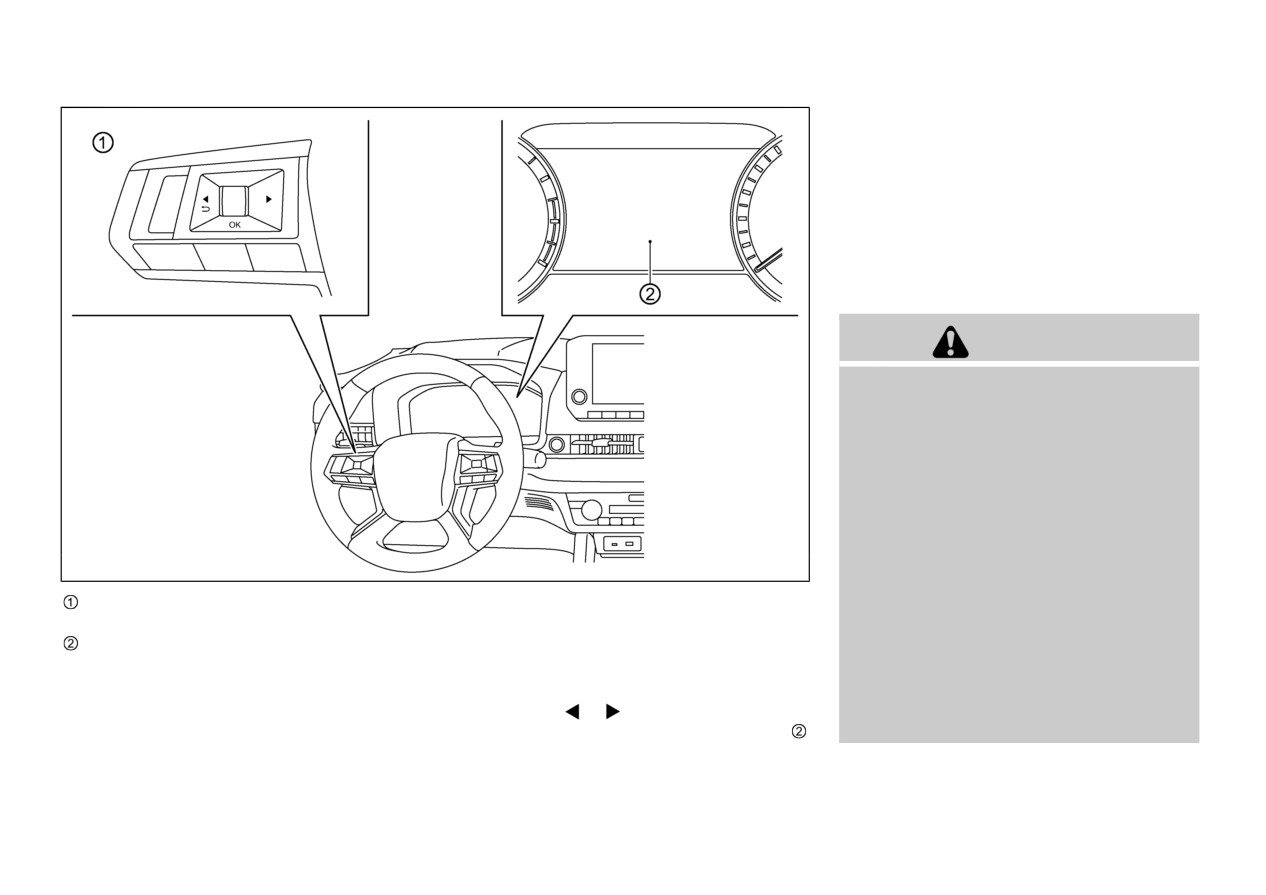
Use the scroll dial to select
“Driver
Assistance.” Then push the scroll dial.
2. Select
“Driver Attention Alert” and push
the scroll dial to turn the system on or off.
NOTE:
The setting will be retained even if the engine
is restarted.
DAA SYSTEM LIMITATIONS
WARNING
Listed below are the system limitations for the
DAA system. Failure to operate the vehicle in
accordance with these system limitations could
result in serious injury or death.
. The DAA system may not operate properly
and may not provide an alert in the
following conditions:
— Poor road conditions such as an
uneven road surface or pot holes.
WAF0591X
— Strong side wind.
Steering wheel remote control
switches
(left
HOW TO ENABLE/DISABLE
— If you have adopted a sporty
side)
driving style with higher corner-
Multi-information display
THE DAA SYSTEM
ing speeds or higher rates of
Perform the following steps to enable or disable
acceleration.
the DAA system.
— Frequent lane changes or changes
1. Press the
button until “Settings”
to vehicle speed.
displays in the multi-information display
Starting and driving
5-145
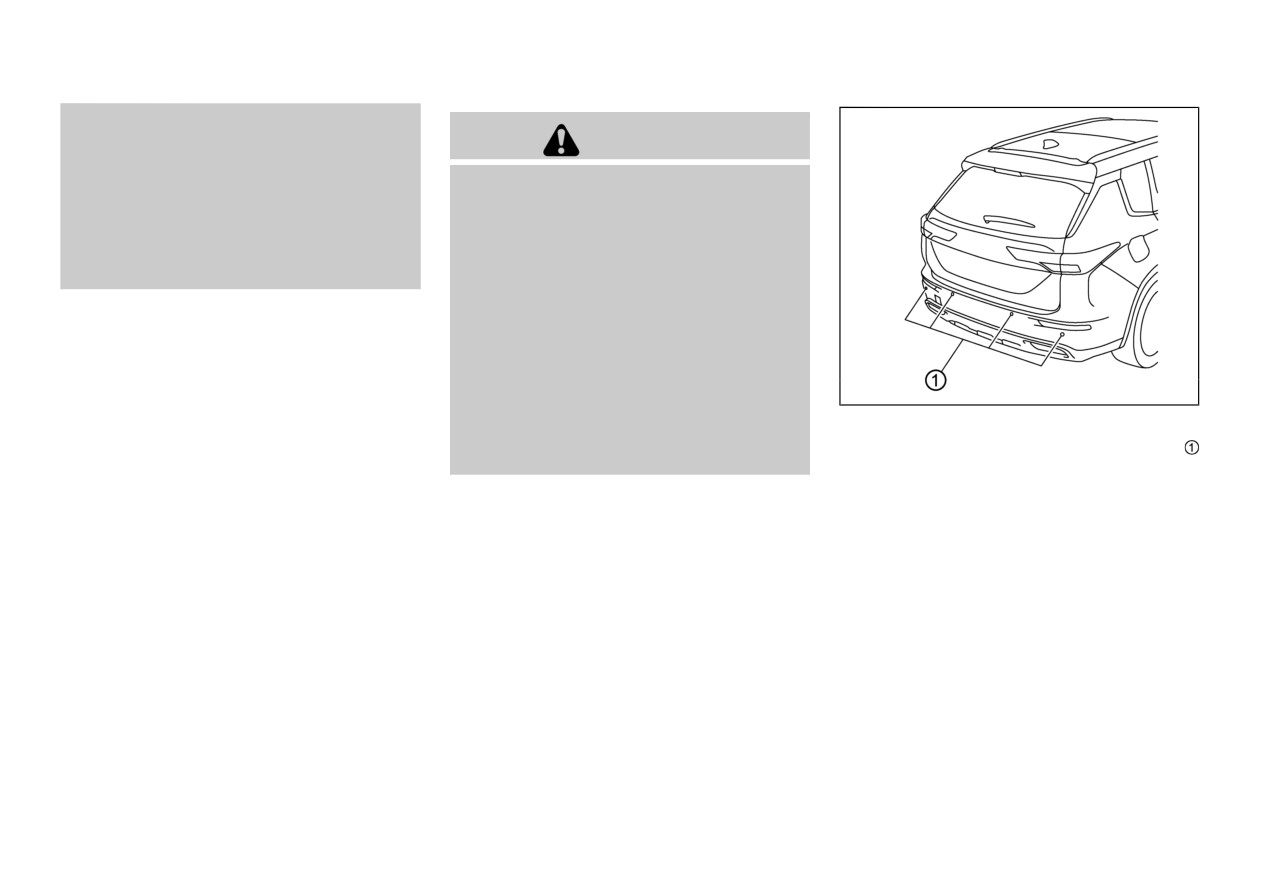
REAR AUTOMATIC EMERGENCY
BRAKING (Rear AEB)
. The DAA system will not provide an alert
in the following conditions:
WARNING
— Vehicle speeds lower than
37
Failure to follow the warnings and instructions
MPH (60 km/h).
for proper use of the Rear AEB system could
— Short lapses of attention.
result in serious injury or death.
— Instantaneous distractions such
. The Rear AEB system is a supplemental
as dropping an object.
aid to the driver. It is not a replacement for
proper driving procedures. Always use the
side and rear mirrors and turn and look in
System malfunction
the direction you will move before and
while backing up. Never rely solely on the
If the DAA system malfunctions, the “Driver
Rear AEB system. It is the driver’s
Attention Alert Malfunction” warning message
responsibility to stay alert, drive safely,
will appear in the multi-information display and
and be in control of the vehicle at all times.
WAF0625X
the function will be stopped automatically.
. There is a limitation to the Rear AEB
The Rear AEB system detects obstacles behind
Action to take
system capability. The Rear AEB system is
the vehicle using the
rear parking sensor
not effective in all situations.
Stop the vehicle in a safe location, place the
located on the rear bumper.
vehicle in P (Park) position, turn the engine off
NOTE:
The Rear AEB system can assist the driver
and restart the engine. If the system warning
when the vehicle is backing up and approaching
You can temporarily cancel the parking
message continues to appear, have the system
checked. It is recommended that you visit an
objects directly behind the vehicle.
sensor function in the vehicle, but the Rear
authorized Mitsubishi Motors dealer for this
AEB system will continue to operate. For
additional information, see
“Rear parking
service.
sensor system” (P.5-169).
5-146
Starting and driving

If a risk of a collision with an obstacle is
detected when your vehicle is backing up, the
Rear AEB system warning indicator
will
flash in the multi-information display and the
system will chime three times. The system will
then automatically apply the brakes. After the
automatic brake application, the driver must
depress the brake pedal to maintain brake
pressure.
NOTE:
. The stop lights of the vehicle come on
when braking is performed by the Rear
AEB system.
. When the brakes operate, a noise may be
heard. This is not a malfunction.
WAF0715X
Rear AEB system OFF warning light
REAR AEB SYSTEM OPERA-
Rear AEB system warning indicator
TION
Multi-information display
When the shift lever is in the R
(Reverse)
Steering wheel remote control switches
(left
side)
position and the vehicle speed is less than
approximately 9 MPH (15 km/h), the Rear AEB
system operates.
Starting and driving
5-147
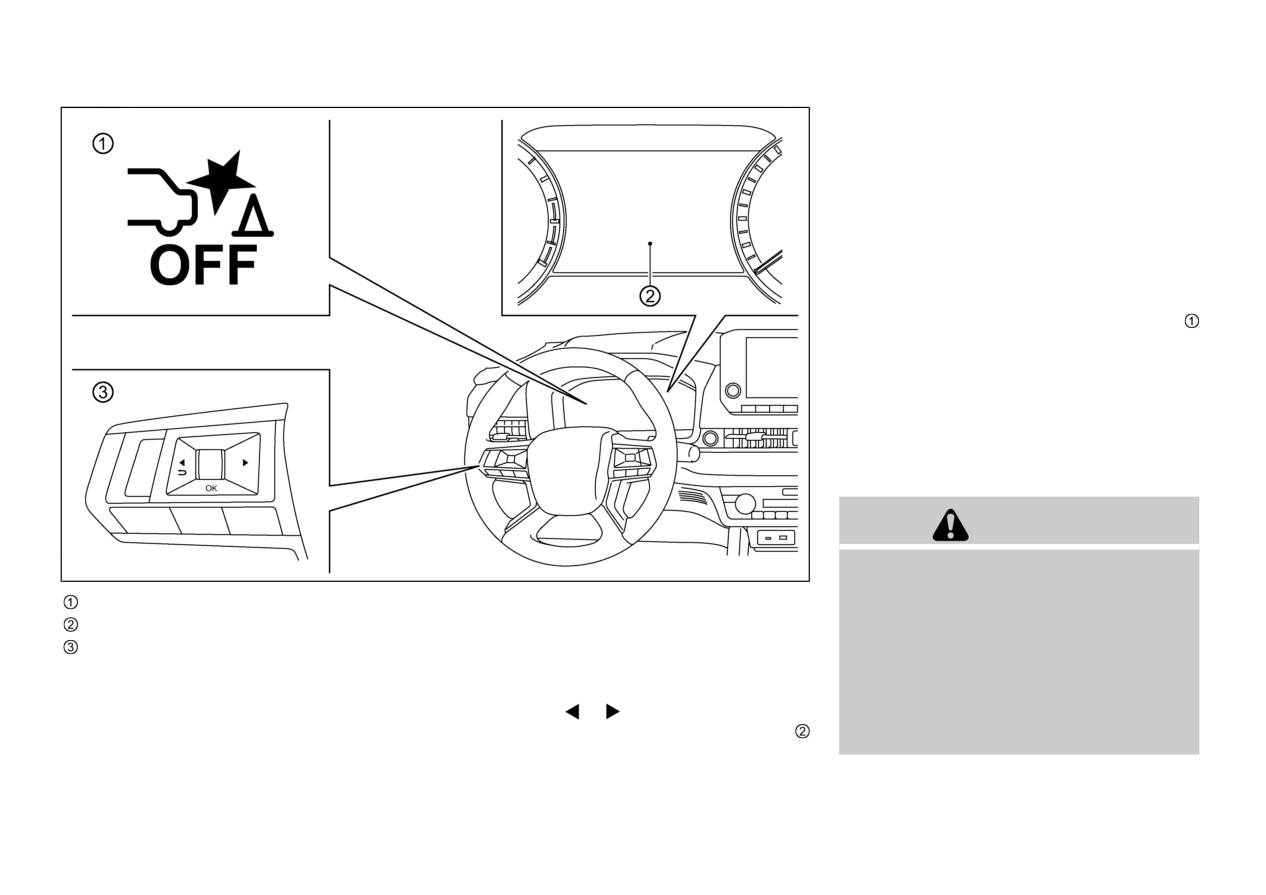
and then push the scroll dial. Use the scroll
dial to select
“Driver Assistance.” Then
push the scroll dial.
2. Select
“Emergency Brake” and push the
scroll dial.
3. To set the Rear AEB system to on or off,
use the scroll dial to check the box for
“Rear”.
When the Rear AEB system is turned off, the
Rear AEB system OFF warning light
illuminates.
NOTE:
The Rear AEB system will be automatically
turned on when the engine is restarted.
REAR AEB SYSTEM LIMITA-
TIONS
WARNING
WAF0654X
Listed below are the system limitations for the
Rear AEB system. Failure to follow the
Rear AEB system OFF warning light
TURNING THE REAR AEB
warnings and instructions for proper use of
Multi-information display
the Rear AEB system could result in serious
SYSTEM ON/OFF
injury or death.
Steering wheel remote control switches
(left
side)
Perform the following steps to turn the Rear
. When the vehicle approaches an obstacle
AEB system ON or OFF.
while the accelerator or brake pedal is
1. Press the
button until “Settings”
depressed, the function may not operate or
the start of the operation may be delayed.
appears in the multi-information display
The Rear AEB system may not operate or
5-148
Starting and driving
may not perform sufficiently due to vehicle
The Rear AEB system may not operate for
— There is a structure (e.g., a wall,
conditions, driving conditions, the traffic
pedestrians or animals.
toll gate equipment, a narrow
environment, the weather, road surface
The Rear AEB system may not operate for
tunnel, a parking lot gate) near
conditions, etc. Do not wait for the system
the following obstacles:
the side of the vehicle.
to operate. Operate the brake pedal by
yourself as soon as necessary.
— Obstacles located high off the
— There are bumps, protrusions, or
ground
manhole covers on the road sur-
If it is necessary to override Rear AEB
operation, strongly press the accelerator
face.
— Obstacles in a position offset from
pedal.
your vehicle
— The vehicle drives through a
Always check your surroundings and turn
draped flag or a curtain.
— Obstacles, such as spongy materi-
to check what is behind you before and
als or snow, that have soft outer
— The vehicle is driving on a steep
while backing up. The Rear AEB system
detects stationary objects behind the vehi-
surfaces and can easily absorb a
hill.
cle. The Rear AEB system does not detect
sound wave
— There is an accumulation of snow
the following objects:
The Rear AEB system may not operate in
or ice behind the vehicle.
— Moving objects
the following conditions:
— An ultrasonic wave source, such
— Low objects
— There is rain, snow, ice, dirt, etc.,
as another vehicle’s parking sen-
attached to the parking sensors.
— Narrow objects
sor, is near the vehicle.
— A loud sound is heard in the area
— Wedge-shaped objects
Once the automatic brake control oper-
around the vehicle.
ates, it does not operate again if the vehicle
— Complex-shaped objects
— The surface of the obstacle is
approaches the same obstacle.
— Multiple object in close
diagonal to the rear of the vehicle.
The automatic brake control can only
operate for a short period of time. There-
— Objects close to the bumper (less
— The parking sensors or the area
fore, the driver must depress the brake
than approximately 1 ft [30 cm])
around them are extremely hot or
pedal.
cold.
— Objects that suddenly appear
In the following situations, the Rear AEB
The Rear AEB system may unintentionally
system may not operate properly or may
— Thin objects such as rope, wire,
operate in the following conditions:
not function sufficiently:
chain, etc.
— There is overgrown grass in the
— The vehicle is driven in bad
area around the vehicle.
weather (rain, fog, snow, etc.).
Starting and driving
5-149
NOTE:
— The vehicle is driven on a steep
— The vehicle is on the chassis
If the Rear AEB system cannot be operated
hill.
dynamometer.
temporarily, the Rear AEB system warning
— The vehicle’s posture is changed
— The vehicle drives on an uneven
light blinks.
(e.g., when driving over a bump).
road surface.
— The vehicle is driven on a slippery
— Suspension parts other than those
road.
designated as genuine parts are
used. (If the vehicle height or the
— The vehicle is turned sharply by
vehicle body inclination is chan-
turning the steering wheel fully.
ged, the system may not detect an
— Snow chains are used.
obstacle correctly.)
— Wheels or tires other than
. Excessive noise (e.g., audio system volume,
Mitsubishi Motors recommended
an open vehicle window) will interfere with
are used.
the chime sound, and it may not be heard.
— The brakes are cold at low
ambient temperatures or immedi-
SYSTEM MALFUNCTION
ately after driving has started.
If the Rear AEB system malfunctions, it will be
turned off automatically, the Rear AEB system
— The braking force becomes poor
warning light will illuminate, and the
“Mal-
due to wet brakes after driving
through a puddle or washing the
sage will appear in the multi-information
vehicle.
display.
Turn the Rear AEB system off in the
following conditions to prevent the occur-
Action to take
rence of an unexpected accident resulting
If the warning light illuminates, park the vehicle
from sudden system operation:
in a safe location, turn the engine off, and restart
— The vehicle is towed.
the engine. If the warning light continues to
— The vehicle is carried on a flatbed
illuminate, have the Rear AEB system checked.
truck.
It is recommended that you visit an authorized
Mitsubishi Motors dealer for this service.
5-150
Starting and driving

BREAK-IN SCHEDULE
parking sensors.
Do not subject the area around the rear
CAUTION
parking sensor to strong impact. Also, do
not remove or disassemble the rear parking
During the first 1,200 miles (2,000 km), follow
sensor. If the rear parking sensor and
these recommendations to obtain maximum
peripheral areas are deformed in an acci-
engine performance and ensure the future
dent, etc., have the sensors checked. It is
reliability and economy of your new vehicle.
Failure to follow these recommendations may
recommended that you visit an authorized
result in shortened engine life and reduced
Mitsubishi Motors dealer for this service.
engine performance.
Do not attach stickers (including transparent
stickers), accessories or apply additional
Avoid driving for long periods at constant
paint on the rear parking sensor and their
speed, either fast or slow. Do not run the
surrounding areas. This may cause a mal-
engine over 4,000 rpm.
WAF0625X
function or improper operation.
Do not accelerate at full throttle in any gear.
When washing the vehicle using a high-
SYSTEM MAINTENANCE
Avoid quick starts.
pressure washer, do not apply direct washer
Observe the following items to ensure proper
pressure on the parking sensors. This may
Avoid hard braking as much as possible.
operation of the system:
cause a malfunction of the parking sensors.
Do not tow a trailer for the first 500 miles
(800 km). Your engine, axle or other parts
. Always keep the rear parking sensor
could be damaged.
clean.
. If the rear parking sensors are dirty, wipe
them off with a soft cloth while being
careful to not damage them.
. The parking sensors may be blocked by
temporary ambient conditions such as
splashing water, mist or fog. The blocked
condition may also be caused by objects
such as ice, frost or dirt obstructing the
parking sensors. Check for and remove
objects obstructing the area around the
Starting and driving
5-151
FUEL EFFICIENT DRIVING TIPS
Follow these easy-to-use Fuel Efficient Driving
4.
Drive at economical speeds and distances.
through the toll and avoid stopping and
Tips to help you achieve the most fuel economy
. Observing the speed limit and not
starting.
from your vehicle.
exceeding 60 MPH (97 km/h) (where
9.
Winter warm up.
1.
Use smooth accelerator and brake pedal
legally allowed) can improve fuel effi-
. Limit idling time to minimize impact to
application.
ciency due to reduced aerodynamic drag.
fuel economy.
. Avoid rapid starts and stops.
. Maintaining a safe following distance
. Vehicles typically need no more than 30
. Use smooth, gentle accelerator and brake
behind other vehicles reduces unneces-
seconds of idling at start-up to effec-
application whenever possible.
sary braking.
tively circulate the engine oil before
. Maintain constant speed while commut-
. Safely monitoring traffic to anticipate
driving.
ing and coast whenever possible.
changes in speed permits reduced brak-
. Your vehicle will reach its ideal operat-
ing and smooth acceleration changes.
2.
Maintain constant speed.
ing temperature more quickly while
. Select a gear range suitable to road
driving versus idling.
. Look ahead to try and anticipate and
conditions.
minimize stops.
10. Keeping your vehicle cool.
. Synchronizing your speed with traffic
5.
Use cruise control.
Park your vehicle in a covered parking
lights allows you to reduce your number
. Using cruise control during highway
area or in the shade whenever possible.
of stops.
driving helps maintain a steady speed.
When entering a hot vehicle, opening the
. Maintaining a steady speed can minimize
. Cruise control is particularly effective in
windows will help to reduce the inside
red light stops and improve fuel effi-
providing fuel savings when driving on
temperature faster, resulting in reduced
ciency.
flat terrains.
demand on your A/C system.
3.
Use air conditioning (A/C) at higher vehicle
6.
Plan for the shortest route.
speeds.
. Utilize a map or navigation system to
. Below 40 MPH (64 km/h), it is more
determine the best route to save time.
efficient to open windows to cool the
7.
Avoid idling.
vehicle due to reduced engine load.
. Shutting off your engine when safe for
. Above 40 MPH (64 km/h), it is more
stops exceeding
30-60
seconds saves
efficient to use A/C to cool the vehicle
fuel and reduces emissions.
due to increased aerodynamic drag.
8.
Buy an automated pass for toll roads.
. Recirculating the cool air in the cabin
. Automated passes permit drivers to use
when the A/C is on reduces cooling load.
special lanes to maintain cruising speed
5-152
Starting and driving
INCREASING FUEL ECONOMY
S-AWC(Super-All Wheel Control) (if so equipped)
Keep your engine tuned up.
S-AWC is an integrated vehicle dynamics
operating, especially GRAVEL, SNOW and
Follow the recommended scheduled main-
control system that helps enhance driving
MUD mode, you may feel a vibration or hear
tenance.
performance, cornering performance, and vehi-
a noise from a underfloor. This is normal and
cle stability over a wide range of driving
indicates that the electronically controlled AWC
Keep the tires inflated to the correct
conditions through integrated management of
is operating properly.
pressure. Low tire pressure increases tire
wear and lowers fuel economy.
the electronically controlled AWC, the AYC
ACTIVE YAW CONTROL
(Active Yaw Control), the ABS and the ASC.
Keep the wheels in correct alignment.
(AYC)
Improper alignment increases tire wear
and lowers fuel economy.
See “Chassis control” (P.5-160).
CAUTION
Use the recommended viscosity engine oil.
S-AWC OPERATION DISPLAY
(See “Engine oil and oil filter recommenda-
Do not over-rely on the S-AWC. Even the S-
The S-AWC operation status can be displayed
tion” (P.10-5).)
AWC cannot prevent the natural laws of
on the information screen in the multi-informa-
physics from acting on the vehicle. This system,
like any other system, has limits and cannot
tion display.
help you to maintain traction and control of
To display the status, change the information
the vehicle in all circumstances. Reckless
screen.
driving can lead to accidents. It is the driver’s
responsibility to drive carefully. This means
(See “How to use the multi-information dis-
taking into account the traffic, road and
play” (P.2-21).)
environmental conditions.
Display example
The S-AWC operation status is displayed.
ELECTRONICALLY CON-
TROLLED AWC
The electronically controlled AWC is a system
that improves acceleration performance and
stability performance by controlling front-rear
distribution of driving torque with operating the
electronic control coupling arranged in the rear
differential assembly.
When the electronically controlled AWC is
Starting and driving
5-153

WARNING
Always concentrate on your driving first. Keep
your eyes and mind on the road. Distractions
while driving can lead to an accident.
WAF0628X
Yaw moment control display:
The amount of the yaw moment control is
displayed as a bar graph.
,
Amount of the yaw moment control in a
clockwise direction
,
Amount of the yaw moment control in a
counterclockwise direction
Traction control:
The strength of the traction control between
front and rear wheels is displayed in section
of the meter as a bar graph.
5-154
Starting and driving
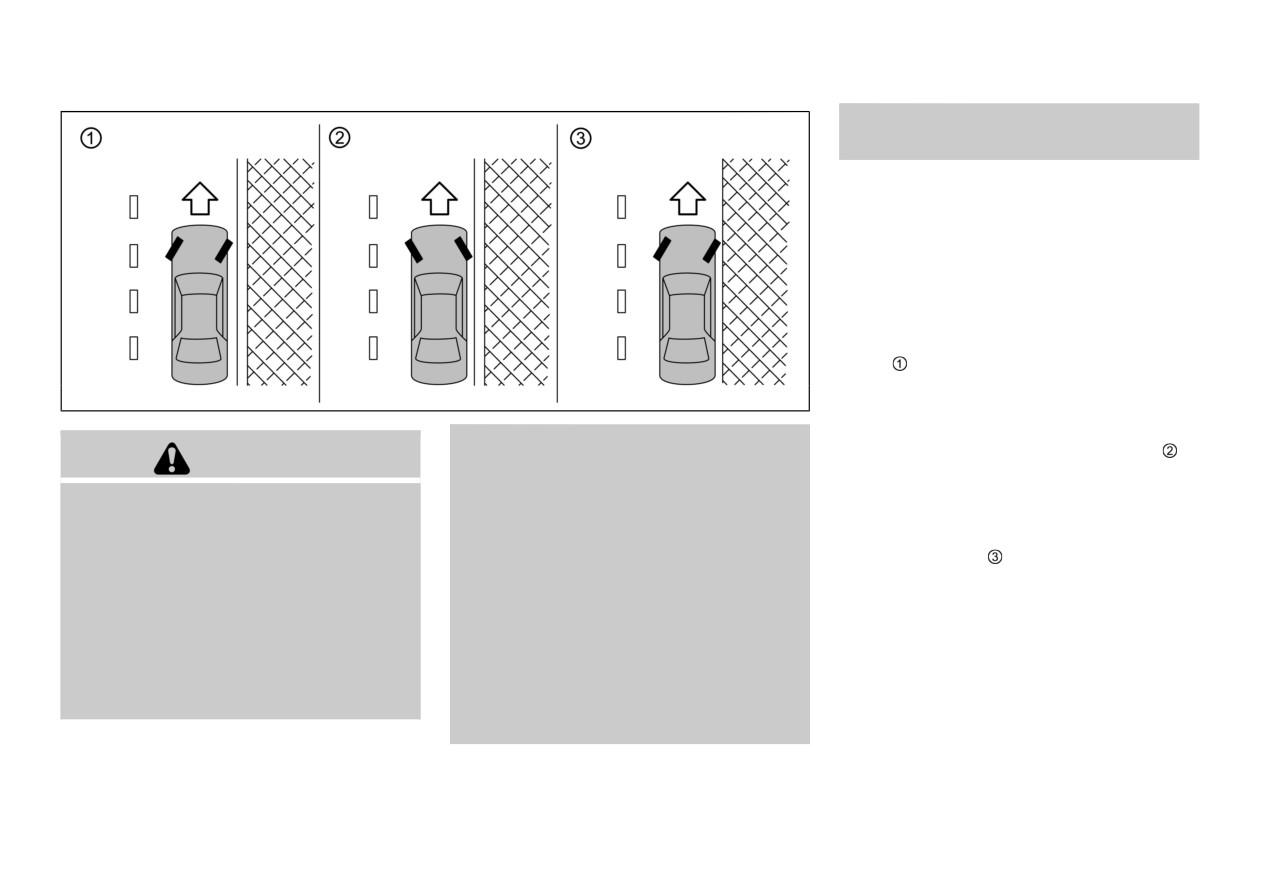
PARKING/PARKING ON HILLS
. Make sure the shift lever cannot be moved
without depressing the foot brake pedal.
1.
Firmly apply the parking brake.
2.
Push the park button to shift to the P (Park)
position.
3.
To help prevent the vehicle from rolling into
the street when parked on a sloping drive
way, it is a good practice to turn the wheels
as illustrated.
. HEADED DOWNHILL WITH CURB:
Turn the wheels into the curb and move
WAF0662X
the vehicle forward until the curb side
wheel gently touches the curb.
To help avoid risk of injury or death
. HEADED UPHILL WITH CURB:
WARNING
through unintended operation of the vehi-
Turn the wheels away from the curb and
cle and/or its systems, do not leave
move the vehicle back until the curb side
Do not stop or park the vehicle over
children, people who require the assistance
wheel gently touches the curb.
flammable materials such as dry grass,
of others or pets unattended in your
vehicle. Additionally, the temperature in-
. HEADED UPHILL OR DOWNHILL,
waste paper or rags. They may ignite and
cause a fire.
side a closed vehicle on a warm day can
NO CURB:
quickly become high enough to cause a
Never leave the engine running while the
Turn the wheels toward the side of the
significant risk of injury or death to people
vehicle is unattended.
road so the vehicle will move away from
and pets.
the center of the road if it moves.
Do not leave children unattended inside
Safe parking procedures require that both
the vehicle. They could unknowingly acti-
4.
Place the ignition switch in the OFF
the parking brake be applied and the
vate switches or controls. Unattended
position.
transmission placed into P (Park). Failure
children could become involved in serious
to do so could cause the vehicle to move
accidents.
unexpectedly or roll away and result in an
accident.
Starting and driving
5-155

ELECTRIC POWER STEERING
BRAKE SYSTEM
is operated quickly. However, this is not a
BRAKING PRECAUTIONS
WARNING
malfunction.
The brake system has two separate hydraulic
If the electric power steering warning light
circuits. If one circuit malfunctions, you will
. If the engine is not running or is turned off
illuminates while the engine is running, it may
still have braking at two wheels.
while driving, the power assist for the
indicate the electric power steering is not
steering will not work. Steering will be
functioning properly and may need servicing.
Brake pedal
harder to operate.
Have the electric power steering checked. It is
Overuse of the brake can cause weakening,
. When the electric power steering warning
recommended that you visit an authorized
resulting in poor brake response and premature
light illuminates with the engine running,
Mitsubishi Motors dealer for this service. (See
wear of the brake pads.
the power assist for the steering will cease
“Electric power steering warning light”
(P.2-
operation. You will still have control of the
When driving down a long or steep hill, use
16).)
vehicle but the steering will be harder to
engine braking by downshifting.
operate.
When the electric power steering warning light
illuminates with the engine running, the power
assist for the steering will cease operation. You
WARNING
The electric power steering is designed to
provide power assist while driving to operate
will still have control of the vehicle. However,
greater steering effort is needed, especially in
Do not leave any objects near the brake pedal
the steering wheel with light force.
or let a floor mat slide under it; doing so could
sharp turns and at low speeds.
When the steering wheel is operated repeatedly
prevent the full pedal stroke that would be
or continuously while parking or driving at a
The mode of the power steering will be changed
necessary in an emergency. Make sure that the
very low speed, the power assist for the steering
automatically in accordance with the vehicle’s
pedal can be operated freely at all times. Make
wheel will be reduced. This is to prevent
drive mode. (See “Drive Mode Selector” (P.5-
sure the floor mat is securely held in place.
overheating of the electric power steering and
28).)
protect it from getting damaged. While the
Vacuum assisted brakes
power assist is reduced, steering wheel opera-
The brake booster aids braking by using engine
tion will become heavy. When the temperature
vacuum. If the engine stops, you can stop the
of the electric power steering goes down, the
vehicle by depressing the brake pedal. How-
power assist level will return to normal. Avoid
ever, greater foot pressure on the brake pedal
repeating such steering wheel operations that
will be required to stop the vehicle and the
could cause the electric power steering to
stopping distance will be longer.
overheat.
You may hear a noise when the steering wheel
5-156
Starting and driving
BRAKE ASSIST
Using the brakes
Wet brakes
BRAKE ASSIST
Avoid resting your foot on the brake pedal
When the vehicle is washed or driven through
When the force applied to the brake pedal
while driving. This will cause overheating of
water, the brakes may get wet. As a result, your
exceeds a certain level, the Brake Assist is
the brakes, wearing out the brake pads faster
braking distance will be longer and the vehicle
activated generating greater braking force than a
and reduce gas mileage.
may pull to one side during braking.
conventional brake booster even with light
pedal force.
To help reduce brake wear and to prevent the
To dry brakes, drive the vehicle at a safe speed
brakes from overheating, reduce speed and
while lightly tapping the brake pedal to heat-up
downshift to a lower gear before going down
the brakes. Do this until the brakes return to
WARNING
a slope or long grade. Overheated brakes may
normal. Avoid driving the vehicle at high
reduce braking performance and could result in
speeds until the brakes function correctly.
The Brake Assist is only an aid to assist
loss of vehicle control.
braking operation and is not a collision
Parking brake break-in
warning or avoidance device. It is the driver’s
Break in the parking brake shoes whenever the
responsibility to stay alert, drive safely and be
WARNING
in control of the vehicle at all times.
stopping effect of the parking brake is wea-
kened or whenever the parking brake shoes and/
While driving on a slippery surface, be
or drums/rotors are replaced, in order to assure
ANTI-LOCK BRAKING SYS-
careful when braking, accelerating or
the best braking performance.
downshifting. Abrupt braking or acceler-
TEM (ABS)
ating could cause the wheels to skid and
This procedure is described in the vehicle
result in an accident.
service manual. It is recommended you visit
an authorized Mitsubishi Motors dealer for this
WARNING
If the engine is not running or is turned off
while driving, the power assist for the
service.
brakes will not work. Braking will be
. The Anti-lock Braking System (ABS) is a
harder.
sophisticated device, but it cannot prevent
accidents resulting from careless or dan-
gerous driving techniques. It can help
maintain vehicle control during braking
on slippery surfaces. Remember that stop-
ping distances on slippery surfaces will be
longer than on normal surfaces even with
ABS. Stopping distances may also be
longer on rough, gravel or snow covered
Starting and driving
5-157
roads, or if you are using tire chains.
Normal operation
Always maintain a safe distance from the
WARNING
The ABS operates at speeds above 3 to 6 MPH
vehicle in front of you. Ultimately, the
(5 to 10 km/h). The speed varies according to
driver is responsible for safety.
Do not pump the brake pedal. Doing so may
road conditions.
. Tire type and condition may also affect
result in increased stopping distances.
braking effectiveness.
When the ABS senses that one or more wheels
are close to locking up, the actuator rapidly
— When replacing tires, install the
Self-test feature
applies and releases hydraulic pressure. This
specified size of tires on all four
The ABS includes electronic sensors, electric
action is similar to pumping the brakes very
wheels.
pumps, hydraulic solenoids and a computer.
quickly. You may feel a pulsation in the brake
— For detailed information, see
The computer has a built-in diagnostic feature
pedal and hear a noise from under the hood or
“Tires” (P.8-24) of this manual.
that tests the system each time you start the
feel a vibration from the actuator when it is
engine and move the vehicle at a low speed in
operating. This is normal and indicates that the
The Anti-lock Braking System (ABS) controls
forward or reverse. When the self-test occurs,
ABS is operating properly. However, the
the brakes so the wheels do not lock during hard
you may hear a “clunk” noise and/or feel a
pulsation may indicate that road conditions are
braking or when braking on slippery surfaces.
pulsation in the brake pedal. This is normal and
hazardous and extra care
is required while
The system detects the rotation speed at each
does not indicate a malfunction. If the computer
driving.
wheel and varies the brake fluid pressure to
senses a malfunction, it switches the ABS off
prevent each wheel from locking and sliding.
and illuminates the ABS warning light on the
By preventing each wheel from locking, the
instrument panel. The brake system then
system helps the driver maintain steering
operates normally, but without anti-lock assis-
control and helps to minimize swerving and
tance.
spinning on slippery surfaces.
If the ABS warning light illuminates during the
self-test or while driving, have the vehicle
Using the system
checked. It is recommended you visit an
Depress the brake pedal and hold it down.
authorized Mitsubishi Motors dealer for this
Depress the brake pedal with firm steady
service.
pressure, but do not pump the brakes. The
ABS will operate to prevent the wheels from
locking up. Steer the vehicle to avoid obstacles.
5-158
Starting and driving